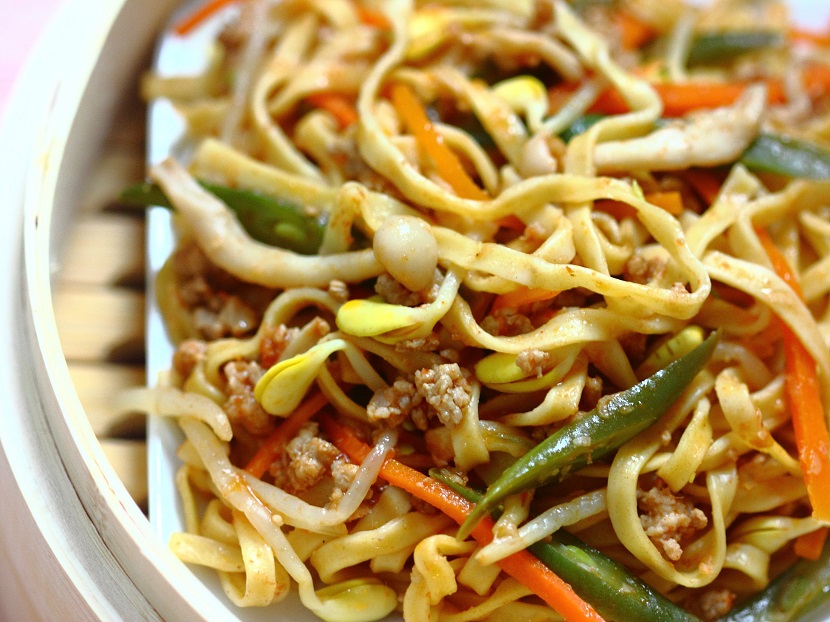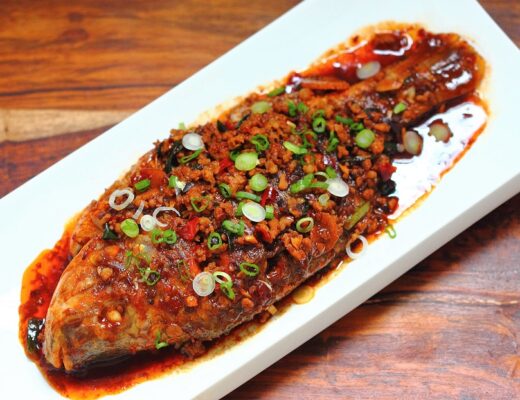Last Updated on October 9, 2020 by Simon Fan
Although noodles are used in all regional cuisines in China, they play a more prominent role in the cooking of central and northern parts of China, where wheat-flour based noodles, dumplings, steamed buns, and pancakes are daily staples.
Henan, a province located in the Yellow River Valley in central China, is widely recognized as the birthplace of Chinese civilization. The local cuisine of Henan is called yu cai (豫菜) and features a myriad of fantastic noodle preparations including our featured dish here.
Called zheng mian (蒸面) in Mandarin, twice-steamed noodles are a result of cooking fresh noodles in the steam twice:
- The first steaming partially cooks the noodles, so they’re softened and ready to absorb the sauce during the next cooking step.
- The second steaming finishes the cooking when the noodles are mixed with the sauce and other ingredients.
For me, steaming twice is such an ingenious way of achieving great texture and flavor for the noodles.
This dish is 100% customizable because you can include any protein or vegetables of your choice and create a satisfying one-dish meal.
In my recipe below, I use pork, tomatoes, string beans, and soybean sprouts—typical ingredients home cooks in Henan would use for this dish. I also include carrots and mushrooms as an autumn version. Feel free to substitute other ingredients or make it vegetarian by omitting the meat and increasing the amount of soybean sprouts.
To fully appreciate this dish, you need to use high-quality fresh noodles. I like to use fresh noodles made with whole eggs. You don’t have to make a trip to Chinatown though: you can use linguine or tagliatelle from your local gourmet pasta store. The noodles in my dish are from Raffetto’s, one of the best in NYC.
Henan twice-steamed noodles (河南蒸面)
Serves 2
Ingredients
Meat sauce
1 large tomato, about 7 oz (200 g)
1 tablespoon vegetable oil
4 garlic cloves, minced
1-inch (2.5 cm) piece of ginger, minced
½ lb (230 g) ground pork or any meat of your choice
½ cup (120 ml) water
1 whole star anise
1 tablespoon soy sauce
1 teaspoon Zhengjiang (Chinkiang) vinegar
Salt and freshly ground white pepper
7 oz (200 g) fresh wheat noodles, preferably made with whole eggs
2 oz (60 g) carrots, cut into thin matchsticks
4 oz (115 g) beech mushrooms or sliced button mushrooms
2 oz (60 g) soybean sprouts, ends removed
4 oz (115 g) string beans, blanched and sliced diagonally
Directions
- Cut the tomato horizontally in half. Grate the cut sides on a box grater to make a tomato sauce and collect it in a bowl.
- Place a wok or skillet over medium-high heat until hot, then swirl in the oil. When the oil starts to shimmer, add the garlic and ginger, and stir-fry until fragrant, about 30 seconds. Add the pork and stir and cook for 3 minutes. Add the tomato sauce, water, star anise, soy sauce, and vinegar. Season lightly with salt and pepper. Bring the mixture to a boil, then reduce to a bare simmer. Cook for 30 minutes.
- While the meat sauce is simmering, spread the noodles in a steamer (either one- or two-tier) lined with cheesecloth. Steam over high heat for 15 minutes. The noodles are partially cooked and softened at this stage.
- When the sauce is ready, add the carrots, mushrooms, and soybean sprouts. Turn up the heat to bring the liquid to a boil and cook for 1 minute. Adjust the seasoning as needed. Pour ½ cup of the sauce (without the solids) into a bowl and reserve.
- Remove the wok from the heat. Add the noodles and string beans. Toss to mix all the ingredients well. Spread the mixture on a plate that fits into a steamer (or two plates into a two-tier steamer). Steam over high heat until the noodles are just cooked through, about 15 minutes.
- Heat the reserved sauce and pour it over the noodles. Serve right away.



